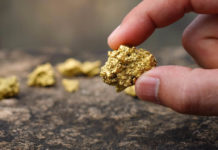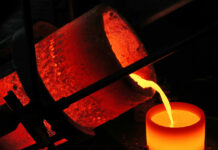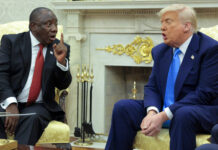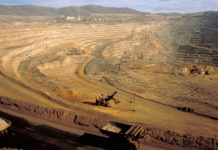
[miningmx.com] — WHILE Australia has been taking South Africa apart on the rugby field major Aussie gold producer Newcrest has been doing the same to Harmony in terms of share price performance.
The two are 50/50 partners in the developing Wafi-Golpu copper/gold project in Papua New Guinea (PNG) which is turning into one of the most promising global mining developments of the past 20 years.
Yet investors have allocated a far higher value to the 50% stake held by Newcrest than the 50% held by Harmony in terms of market cap and they have just shown themselves to be far less nervous about Newcrest’s prospects than Harmony’s.
Harmony CEO, Graham Briggs, spelt it all out at the company’s investor day held recently in Johannesburg.
Briggs pointed out upfront that one key difference between Harmony’s predominantly South African shareholder base and Newcrest’s predominantly Aussie shareholder base concerned the knowledge base on porphyry geological formations such as Wafi-Golpu.
These are common in South East Asia – where they are closely linked to the Pacific “Rim of Fire’ – and well-known to Aussie investors but are largely unknown in Africa.
That is perhaps one of the reasons why, as Briggs pointed out, investors reckon that Newcrest’s half of Wafi-Golpu is worth between $3.5bn and $4bn in terms of the company’s market cap but Harmony’s share is valued at only between $1.5bn and $2bn.
The Harmony share price had risen from a 12-month low of R72 to a high of R104.70 by early August as the message started to get through on the potential value of Wafi-Golpu.
Then the wheels came off on the back of reporting from Australia on potential political changes to land tenure in PNG which could affect the project.
The Harmony share plunged back to around R87 on August 22 from where it has since recovered to around R98/share.
But the Newcrest share price dipped just 5% to A$39 from A$41 before recovering the lost ground almost immediately.
Briggs told investors, “I do not believe next year’s elections in PNG will cause any disruptions to our plans for Wafi-Golpu. The government, the provincial government and the landowners all want this project to go ahead.
“The PNG government does not intend nationalisation yet some people have taken this all the way to the Doomsday scenario.’
Briggs was quizzed by JP Morgan Cazenove analyst Steve Shepherd who was concerned that Harmony was not doing enough to get the message across about the fundamental changes that have taken place to the business over the past three years.
Shepherd reckoned that Harmony was trading at around 40% of its nominal value on current gold prices north of R400,000/kg.
Briggs agreed the group was undervalued and backed that up with earnings forecasts which showed that – assuming a sustained gold price of R350,000/kg – Harmony would be able to fund its half of the estimated $3bn total cost of building Wafi-Golpu internally.
One of the major concerns voiced about Harmony has been over how it would fund that capital outlay.
Financial director Hannes Meyer said that, despite the favourable cash flow forecast, Harmony would still put in place a loan facility of between $750m and $1bn to ensure financial flexibility.
Briggs commented, “a lot of investors still clearly hold the view that Harmony is a high-cost, low-grade marginal operator that is very South African focused.
“That’s not where we are taking the company and our operations are distinctly different to those of just a few years ago since when we have closed down ten loss-making shafts.’
Underlining the new strategy Briggs pointed out that should the group list its Evander division separately, it would do so using “other peoples’ money’.
He commented: “Our major shareholders want us to stay focused on PNG. They won’t support us on an expansion of Evander because of the South African investment issues.”









